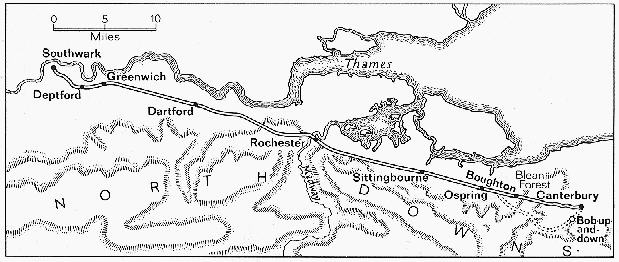|

|
| The Pilgrim's Path from Southwark to Canterbury |
 ven though Chaucer does not tell us how the pilgrims traveled, it is easy to trace the way they must have gone. The
street leading from Southwark is an old Roman road and today is known as Old Kent Road, and eventually becomes New Kent Road.
In Chaucer's day it was called Watling Street, and it can still be followed to Canterbury or to Dover. (Interestingly, Chaucer
writes of Watling Street in his poetry, but only in its usage as a common Medieval nickname for the Milky Way.) Leaving Southwark,
the travelers would have passed through Deptford, Greenwich, and ended their first day in the town of Dartford. From Dartford
they would have traveled to Rochester, crossed the river Medway, then gone on to Sittingbourne, Ospring, and Boughton-under-Blee.
From here they would have either continued on Watling Street straight to Canterbury, or would have taken a southerly shortcut
through Bob-up-and-down, depending on which road was in the best condition. Once they had reached Canterbury, the pilgrimage
was over, for to Medieval man the pilgrimage was a symbolic journey that represented the course of human life, from one's
home on earth to one's true home in the universal order. A pilgrimage was therefore declared over at its destination, and
the return home was not part of the ritual act. ven though Chaucer does not tell us how the pilgrims traveled, it is easy to trace the way they must have gone. The
street leading from Southwark is an old Roman road and today is known as Old Kent Road, and eventually becomes New Kent Road.
In Chaucer's day it was called Watling Street, and it can still be followed to Canterbury or to Dover. (Interestingly, Chaucer
writes of Watling Street in his poetry, but only in its usage as a common Medieval nickname for the Milky Way.) Leaving Southwark,
the travelers would have passed through Deptford, Greenwich, and ended their first day in the town of Dartford. From Dartford
they would have traveled to Rochester, crossed the river Medway, then gone on to Sittingbourne, Ospring, and Boughton-under-Blee.
From here they would have either continued on Watling Street straight to Canterbury, or would have taken a southerly shortcut
through Bob-up-and-down, depending on which road was in the best condition. Once they had reached Canterbury, the pilgrimage
was over, for to Medieval man the pilgrimage was a symbolic journey that represented the course of human life, from one's
home on earth to one's true home in the universal order. A pilgrimage was therefore declared over at its destination, and
the return home was not part of the ritual act. - from Pilgrims Passing to
and Fro
ridgeriders website is
©2004/2005/2006/2007/2008/2009/ 2010/2011/2012/2013.2014
all rights reserved
|

